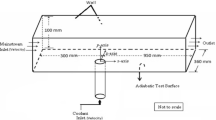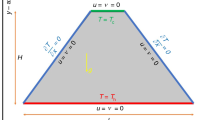Abstract
The fire induced flow characteristics through horizontal passage between two enclosures are investigated under natural and forced ventilation conditions. The physical model consists of upper and lower enclosures with door openings through which forced air enters the dual enclosure. Transient three-dimensional simulations are performed by Large Eddy Simulations (LES) using Fire Dynamic Simulator (FDS) code. The assisting and opposing behavior of forced air stream in enclosure fire are investigated by varying fire source locations. The flow characteristics through horizontal and vertical passages are found to be oscillatory and bidirectional. In natural ventilation conditions, heat source location and thermal buoyancy force change the flow characteristics in dual enclosures. Under forced ventilation conditions, ambient air stream significantly affects fire transport phenomena by aiding or opposing the thermal buoyancy force. At higher velocity inlets, ambient air diffuses heat from fire and reduces temperature gradients inside dual enclosure. The forced air stream dominates buoyancy force and drives hot gases to propagate in reverse direction. The critical ventilation velocity that prevents the spreading of thermal plume from doorway opening is identified. The model employed has been validated with the existing experimental results available in literature.
Similar content being viewed by others
References
Andersen KT (2007). Airflow rates by combined natural ventilation with opposing wind-unambiguous solutions for practical use. Building and Environment, 42: 534–542.
Cheng CCK, Lam KM, Yuen RKK, Lo SM, Liang J (2007). A study of natural ventilation in a refuge floor. Building and Environment, 42: 3322–3332.
Cheng CCK, Lam KM, Demirbilek FN (2008). Effects of building wall arrangements on wind-induced ventilation through the refuge floor of a tall building. Journal of Wind Engineering and Industrial Aerodynamics, 96: 656–664.
Chen H, Liu N, Chow W (2009). Wind effects on smoke motion and temperature of ventilation-controlled fire in a two-vent compartment. Building and Environment, 44: 2521–2526.
Chen HX, Liu NA, Chow WK (2011). Wind tunnel tests on compartment fires with crossflow ventilation. Journal of Wind Engineering and Industrial Aerodynamics, 99: 1025–1035.
Chow WK, Zou GW (2005). Correlation equations on fire-induced air flow rates through doorway derived by large eddy simulation. Building and Environment, 40: 897–906.
Chow WK, Li J (2011). On the bidirectional flow across an atrium ceiling vent. Building and Environment, 46: 2598–2602.
Harish R, Venkatasubbaiah K (2013a). Mathematical modeling and computation of fire induced turbulent flow in partial enclosures. Applied Mathematical Modelling, 37: 9732–9746.
Harish R, Venkatasubbaiah K (2013b). Numerical simulation of turbulent plume spread in ceiling vented enclosure. European Journal of Mechanics-B/Fluids, 42: 142–158.
Hu LH, Huo R, Yang D (2009). Large eddy simulation of fire-induced buoyancy driven plume dispersion in an urban street canyon under perpendicular wind flow. Journal of Hazardous Materials, 166: 394–406.
Huang H, Ooka R, Liu N, Zhang L, Deng Z and Kato S (2009). Experimental study of fire growth in a reduced-scale compartment under different approaching external wind conditions. Fire Safety Journal, 44: 311–321.
Hu LH, Liu S, Xu Y, Li D (2011). A wind tunnel experimental study on burning rate enhancement behavior of gasoline pool fires by cross air flow. Combustion and Flame, 158: 586–591.
Jiang Y, Chen Q (2001). Study of natural ventilation in buildings by large eddy simulation. Journal of Wind Engineering and Industrial Aerodynamics, 89: 1155–1178.
Karava P, Stathopoulos T, Athienitis AK (2007). Wind-induced natural ventilation analysis. Solar Energy, 81: 20–30.
Lax PD (1967). Hyperbolic difference equations: a review of the Courant-Friedrichs-Lewy paper in light of recent developments. IBM Journal of Research and Development, 11: 235–238.
Lassus J, Courty L, Garo JP, Studer E, Jourda P, Aine P (2014). Ventilation effects in confined and mechanically ventilated fires. International Journal of Thermal Sciences, 75: 87–94.
Li Y, Delsante A (2001). Natural ventilation induced by combined wind and thermal forces. Building and Environment, 36: 59–71.
Liu Z, Zhao B, Yang X (2007). A Method for calculating a ventilation bypass factor. Indoor and Built Environment, 16: 472–481.
Lu WZ, Lo SM, Fang Z, Yuen KK (2001). A CFD Study of air movement in designated refuge floor. International Journal of Computational Fluid Dynamics, 15: 169–176.
McGrattan K, Hostikka S, Floyd J, Baum H, Rehm R (2007a). Fire Dynamics Simulator (Version 5) Technical Reference Guide. NIST Special Publication, USA.
McGrattan K, Klein B, Hostikka S, Floyd J (2007b). Fire Dynamics Simulator (Version 5) Users Guide. NIST Special Publication, USA.
Meroney RN (2011). Wind effects on atria fires. Journal of Wind Engineering and Industrial Aerodynamics, 99: 443–447.
Nakaya I, Tanaka T, Yoshida M, Stechler K (1986). Doorway flow induced by a propane fire. Fire Safety Journal, 10: 185–195.
Oka Y, Sugawa O, Imamura T (2008). Correlation of temperature rise and velocity along an inclined fire plume axis in crosswinds. Fire Safety Journal, 43: 391–400.
Poreh M, Trebukov S (2000). Wind effects on smoke motion in buildings, Fire Safety Journal, 35: 257–273.
Stathopoulos T (1997). Computational wind engineering: Past achievements and future challenges. Journal of Wind Engineering and Industrial Aerodynamics, 67: 509–532.
Stavridou AD, Prinos PE (2013). Natural ventilation of buildings due to buoyancy assisted by wind: Investigating cross ventilation with computational and laboratory simulation. Building and Environment, 66: 104–119.
Smagorinsky J (1963). General circulation experiments with primitive equations I. The basic experiment. Monthly Weather Review, 91: 99–164.
Yeoh GH, Yuen KK (2009). Computational Fluid Dynamics in Fire Engineering: Theory, Modelling and Practice. Burlington, MA, USA: Butterworth-Heinemann Publications, USA.
Zhang W, Chen Q (2000). Large eddy simulation of indoor airflow with a filtered dynamic subgrid scale model. International Journal of Heat and Mass Transfer, 43: 3219–3231.
Author information
Authors and Affiliations
Corresponding author
Rights and permissions
About this article
Cite this article
Harish, R., Venkatasubbaiah, K. Large eddy simulation of thermal plume behavior in horizontally partitioned dual enclosure. Build. Simul. 8, 137–148 (2015). https://doi.org/10.1007/s12273-014-0198-z
Received:
Revised:
Accepted:
Published:
Issue Date:
DOI: https://doi.org/10.1007/s12273-014-0198-z




